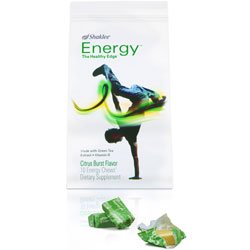Natural Energy Boosters can give you more energy without side effects and without excess sugar or caffeine.

Do you wonder what the heck is going on in your cells that you never seem to have enough energy? Well maybe that’s not the first thing that comes to your mind, but that is where your energy ‘should’ come from. And what feeds the cells makes a difference.
This is a more technical explanation for how our bodies make and use energy. The post that will follow will contain more in terms of lifestyle choices that we can make to create more fuel and help us feel energized throughout the day, every day! And if you still struggle to have daily energy, or you simply want to have some extra energy that you can ‘chew on’ when you need a quick boost, we have a solution for that as well!
Did anyone ever tell you that what you feed your body can have a direct result in how you feel? Every cell in our body has to convert nutrients into energy in order to help do things like: grow hair, pump blood through arteries, send nerve signals to the brain, or move muscles.
How is energy produced in our body?
Metabolism is the process where nutrients are converted to energy. Metabolism converts food into a constant supply of energy that every cell in the body needs.
We need a steady diet of energy foods that are converted into sustained energy that are used at e cellular level in order to feel like we have energy throughout the day.
In simple terms, metabolism refers to the rate at which we burn calories. And a more complex explanation – you may remember from high school biology class – is that metabolism is the sum total of all the complex chemical and hormonal processes related to digesting, absorbing, converting and ultimately using food to produce cellular energy.
So where do we get energy? It all starts with the food chain, and with photosynthesis – the way plants capture the sun’s energy from sunlight and combine with carbon dioxide from the air and water and minerals from the ground to create sugar which the plant stores for energy and oxygen which gets released into the atmosphere.
Whether you eat the plant matter directly, or animals that have consumed the plant matter, there are 3 basic classes of micro nutrients that are vital for life: amino acids from protein, mono and polysaccharides (sugars from carbohydrates), and fatty acids from fats.
All metabolic reactions fall into one of 2 categories: 1) catabolic – creation of energy from breaking down large complex compounds like proteins, carbohydrates, and fats into smaller units, and 2) anabolic – uses smaller building block compounds like amino acids, monosaccharides like glucose, and fats to build cells, tissues, and eventually organs.
The most important source of energy in human metabolism is glucose – when glucose is metabolized in the body it produces carbon dioxide, water, and a few nitrogen compounds, and most important, energy which can be utilized by the cells. Some of this energy is released as heat which is essentially the burning of calories – the rest is used to drive another process in the body called ATP (synthesis of adenosine triphosphate). ATP is the key molecular unit of currency that transfers the energy released by catabolic reactions to the energy requiring anabolic reactions.
In other words, catabolic reactions provide the chemical energy that anabolic reactions need to maintain and grow cells. What initiates catabolic reactions? Many different hormones in the body including cortisol and adrenaline.
This explains why stress impacts metabolism – there are also many other hormones and other processes that influence metabolism. And while metabolism occurs during the digestion of food, there are other catabolic reactions in the body.
If the body is not getting enough energy from food, the body will break down muscle protein and turn the amino acids into fuel while it holds on to fat. Fat stores are only used on pure starvation mode.
How do we store energy? If catabolic reactions break down matter into small units to produce energy, anabolic reactions will consume energy to construct tissues (build muscle and fat cells) that are stored as potential sources of energy if needed.
A processes that will influence energy production is blood glucose regulation – while low energy is frequently due to low blood sugar levels that can be effectively managed by daily diet, the entry of glucose into most tissues is dependent on the presence of the hormone insulin.
Insulin controls the uptake and metabolism of glucose in your cells and plays a major role in regulating blood glucose concentrations in the body which has a direct influence on a person’s energy levels.
Overeating – taking in more energy than your body needs – will, over time, lead to the cells of your body becoming insulin resistant. That results in cells not being able to utilize glucose which can lead to elevations in blood glucose circulating in body, and can be damaging to cells and tissue. Ultimately, this excessive energy intake will lead to Type 2 Diabetes which can damage arteries, lead to heart disease, kidney disease, and even blindness.
How is cellular energy produced? All cells of the body contain dozens to hundreds of mitochondria (organelles in the cell) – think of them as cellular power plants. They are what actually generates ATP to power cellular activities. The number and efficiency of mitochondria decline over time. As we age, our cells have both fewer and less efficient mitochondria. Current thinking is that this mitochondrial decline contributes to diseases of aging.
How is what we eat turned into energy? Macronutrieints are carbohydrates, proteins and fats. Carbohydrates come in three forms: simple sugars, complex carbs (starch) and undigestible carbs (fiber). Our diets tend to contain plenty of sugars and starches but often not enough fiber.
Simple sugars and starches are most easily utilized as direct sources of energy for our cells. If your body takes in more carbohydrates than you actually need, these excess carbohydrates can be stored temporarily as glycogen – in either your liver or in your muscle – and this can be converted into fats, amino acids, and glucose as needed.
The body needs both simple and complex carbohydrates. Simple carbs are the simplest form of sugar and most basic building blocks. Complex carbs like starches and fiber form larger building blocks. Since body tissues need glucose at all times, diets need significant amounts of carbs to yield glucose through digestion and metabolism. Most diets contain carbs as more than half of daily diet.
Protein is the chief muscle and tissue builder of the body – and also helps to make hemoglobin in blood, carry oxygen to cells, form antibodies to fight infection, and supply nitrogen for the production of DNA and RNA. Protein also helps to supply energy for the body.
Digestion breaks protein down into its individual amino acids. If amino acids are in excess of the body’s requirement, they are metabolized to nitrogen and can be stored as fat – for later energy metabolism, or they are eliminated by the kidneys. The most common dietary protein sources are meat, fish, and dairy sources including milk. They can all be high in fat because they are all animal products. Soy beans and other legumes are vegetarian sources, have less fat, and are far more heart healthy.
Fats make up part of the structure of cells, form protective cushion and heat insulation around vital organs, carry fat soluble vitamins, and help store energy.
Many of us get too much fat in the diet. On a weight basis, they contain more than twice as much stored energy or calories as carbohydrates and protein. Fats provide 9 calories per gram compared to 4 calories per gram for carbohydrates and protein.
Other important nutrients that help energy in the body are B-Vitamins (also called the ‘happy’ vitamins), and Magnesium that is involved in 300 chemical reactions in the body, including the breakdown of glucose for energy. Women who have low levels of magnesium in their bodies may have higher heart rates and require more oxygen – their hearts and lungs will need to work harder to accomplish same amount of work. Zinc, potassium, and iron are other nutrients involved in energy production by the body.
When you can’t get enough energy from your foods and your lifestyle, and you want some extra natural energy for mid-afternoon when you are about to fall asleep on the job, or for a busy evening after a busy work day, or even for a long car ride so that you stay awake and alert, and for lots of other reasons you may need more energy, consider Shaklee Energy Chews – 100% satisfaction guaranteed, from the #1 Natural Nutrition Company in the U.S. – a safe and healthy energy booster that also improves alertness and focus without being high in sugar, caffeine and artificial ingredients.
Shaklee Energy Chews provide a clean burst of healthy energy to help you get that extra edge when you need it most. Each chew contains a scientific blend of caffeine from natural green tea extract, plus L-tyrosine, L-theanine, B vitamins and vitamin D. And there are no artificial flavors, sweeteners or added preservatives you’ll find in other energy products.

Also see our sister Energy article, and learn more here about a natural and healthy Energy Chew that gives a safe: BOOST of ENERGY. For sustained energy throughout the day, Natural Energy with Panax Ginseng, Cordyceps and Green Tea and Energy Tea , and Shaklee Life Shake are all very beneficial.
*These statements have not be endorsed by Shaklee Corporation but are the sole testimony of an individual.



Pingback: Low Energy & Fatigue #1 Complaint to Doctors